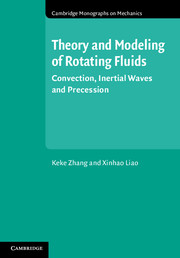Book contents
- Frontmatter
- Contents
- Preface
- Part 1 Fundamentals of Rotating Fluids
- Part 2 Inertial Waves in Uniformly Rotating Systems
- Part 3 Precession and Libration in Non-uniformly Rotating Systems
- 9 Introduction
- 10 Fluid Motion in Precessing Narrow-gap Annuli
- 11 Fluid Motion in Precessing Circular Cylinders
- 12 Fluid Motion in Precessing Spheres
- 13 Fluid Motion in Longitudinally Librating Spheres
- 14 Fluid Motion in Precessing Oblate Spheroids
- 15 Fluid Motion in Latitudinally Librating Spheroids
- Part 4 Convection in Uniformly Rotating Systems
- Appendix A Vector Identities and Theorems
- Appendix B Vector Definitions
- References
- Index
11 - Fluid Motion in Precessing Circular Cylinders
from Part 3 - Precession and Libration in Non-uniformly Rotating Systems
Published online by Cambridge University Press: 26 May 2017
- Frontmatter
- Contents
- Preface
- Part 1 Fundamentals of Rotating Fluids
- Part 2 Inertial Waves in Uniformly Rotating Systems
- Part 3 Precession and Libration in Non-uniformly Rotating Systems
- 9 Introduction
- 10 Fluid Motion in Precessing Narrow-gap Annuli
- 11 Fluid Motion in Precessing Circular Cylinders
- 12 Fluid Motion in Precessing Spheres
- 13 Fluid Motion in Longitudinally Librating Spheres
- 14 Fluid Motion in Precessing Oblate Spheroids
- 15 Fluid Motion in Latitudinally Librating Spheroids
- Part 4 Convection in Uniformly Rotating Systems
- Appendix A Vector Identities and Theorems
- Appendix B Vector Definitions
- References
- Index
Summary
Formulation
Consider a viscous, incompressible, and homogeneous [in Equation (1.10)] fluid without the influence of an external force [f ≡ 0 in Equation (1.10)] occupying a circular cylinder of radius and length d with aspect ratio. The cylinder, as depicted in Figure 11.1, rotates rapidly with an angular velocity, where
is constant, about its axis of symmetry and precesses slowly with an angular velocity that is fixed in an inertial frame (i.e., at an angle α, 0 < α ≤ π/2. In comparison to a precessing sphere or spheroid, it is the extra geometric parameter that enriches the dynamics of fluid motion in precessing cylinders.
We shall adopt cylindrical polar coordinates with s=0 representing the symmetry axis and z = 0 at the bottom surface along with the corresponding unit vectors fixed in the cylinder. In these coordinates, the precession vector is time-dependent in the form
where denotes the amplitude of the precession vector. It follows that the Poincaré forcing, required on the right-hand side of Equation (1.10), is
On inserting the expression for the overall angular velocity and into Equation (1.10), the equation of motion in the mantle or body frame governing the processionally driven flow in a circular cylinder reads as
where p is the reduced pressure containing all the gradient terms. The last term on the righthand side represents the Poincaré forcing which drives precessional flows against viscous dissipation.
On employing the depth d as the length scale, as the unit of time and as the unit of pressure, we obtain the dimensionless equations in the mantle frame describing fluid motion in a precessing cylinder
In the mantle frame of reference, the flow on the bounding surface S of a precessing cylinder is at rest, imposing
on the bottom z = 0 as well as on the top z = 1, and
on the sidewall.
Information
- Type
- Chapter
- Information
- Theory and Modeling of Rotating FluidsConvection, Inertial Waves and Precession, pp. 164 - 212Publisher: Cambridge University PressPrint publication year: 2017
